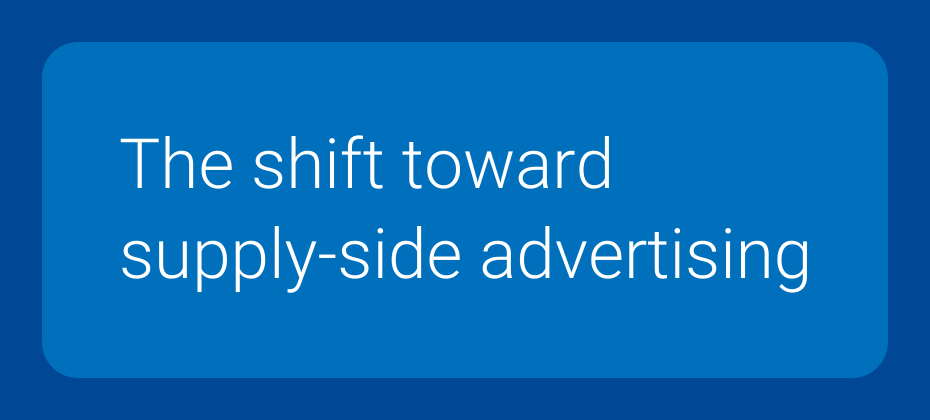Manage your data
The latest trends in data management, including collection, cleanliness, security, linkage and accessibility.

Ongoing signal loss is driving marketers, agencies, and platforms to turn to supply-side advertising. By using first-party data from publishers and platforms, supply-side advertising has the potential to deliver high-quality audience and context for more effective ad targeting. The supply-side refers to the publishers and platforms that sell advertising inventory. These companies have access to first-party data about their users, which can be used to target ads more effectively. By tapping into supply-side advertising, you can overcome the challenges of signal loss and target ads more effectively. To shed light on this topic, we hosted a panel discussion at Cannes, featuring industry leaders from Audigent, Captify, Newsweek, Pubmatic, Truthset, and Experian. In this blog post, we'll explore how partnerships between supply-side channels and publishers are working to enhance advertising opportunities while balancing the need for transparency and control in programmatic ad buying. Shift toward supply-side advertising Traditionally, the demand-side dominated the programmatic media buying chain due to an abundance of supply. However, with the emergence of finite data and its interpretation, collaboration between supply-side technology companies and publishers is required to redefine these economics. It's no longer sufficient for the demand-side to blindly negotiate prices based on limited knowledge. Marketers can still define their target audience, but effective communication is key. This presents an opportunity for premium journalistic outlets to guide the industry's understanding of how data from the supply-side impacts media buying economics in the future. "Supply-side technology partnerships with publishers are now in a position to shape the economics of programmatic media buying as there is a finite amount of data. It’s crucial for supply-side technology companies to collaborate with publishers to shape these new economics. This presents an opportunity for premium journalistic outlets to provide guidance on how data from the supply-side can affect the future of media buying." matthew papa, svp, business & corporate development, captify Democratizing data from the supply-side Cookies haven't brought significant benefits to premium publishers. They mainly serve to retarget users from sites like The Wall Street Journal to advertising sites. This approach primarily serves the purpose of generating revenue. The elimination of third-party cookies presents an opportunity for premium publishers to shift this dynamic. By using their knowledge of first-party audiences, and using identifiers like Experian's LUID, publishers can own and understand their audience data, which can then be modeled. Here’s how publishers can win Establishing a connection with consumers and emphasizing the value exchange is essential to building trust. Determining what incentives and benefits consumers find meaningful will be crucial in gaining their opt-in. With consumers The Apple tracking transparency initiative, specifically the deprecation of IDFA signals, had significant implications for mobile app developers. Overnight, opt-in rates plummeted, causing a drastic decline in iOS ad monetization. To combat this, developers focused on demonstrating the value exchange to consumers—better ad experiences and personalized content. By articulating the benefits over a couple of years, opt-in rates increased from 10-15% to 30-40%. The key takeaway is the need to effectively communicate the value exchange to consumers. With partners Trust plays a crucial role in planning your first-party data strategy. Publishers, advertisers, and data partners highly value their proprietary data. However, there are concerns about how it's used, mishandled, or leaked in the ecosystem. Building trust between partners is essential. It's important to work with trustworthy partners who are agnostic, committed to innovative solutions, and globally oriented. These partners can help navigate the complexities of laws and regulations. Choosing the right partners is crucial in a world where first-party data is a key asset. "Power is shifting toward brands that have strong relationships with customers and possess first-party data. As the ownership of customer data becomes more important, it is crucial to establish a first-party data strategy to better serve customers and adapt to changing market dynamics."chip russo, president, truthset Balance probabilistic and deterministic data Focus on building trust with consumers and collaborating with reliable companies to share data. However, it's important to remember that achieving a 100% opt-in rate is unlikely. The cookie, which has become omnipresent, requires us to shift our strategic thinking. We need to consider both deterministic and probabilistic approaches instead of viewing them as mutually exclusive. The landscape will be fragmented, with some consumers opting in and others not. "Probabilistic and predictive audience data holds immense potential. With the power of AI, we can expect enhanced performance and efficacy in media campaigns. At Audigent, we firmly believe that this data will outperform deterministic data, making it an integral part of our strategy." drew stein, ceo, audigent Premium content Trust plays a crucial role in leading to premium content. By placing trust in the best media brands, data, and technology partners, we can expect to see improvements in media, journalism, and advertising. This shift may have a direct impact on the long tail of free natural resources, making it more challenging for them to thrive. However, this change is ultimately beneficial since it promotes higher-quality media experiences overall. "The homepage surface is making a comeback in the publishing industry, proving its value in establishing a direct connection with readers. While we acknowledge the importance of technology partnerships for addressability and identity, our core competency as a publisher remains outstanding journalism that captures and engages great audiences." kevin gentzel, cco, newsweek Watch our Cannes panel for more on supply-side advertising We hosted a panel in Cannes that covered supply-side advertising. Check out the full recording below to hear what leaders from Audigent, Captify, Newsweek, Pubmatic, Truthset, and Experian had to say. Watch now Check out more Cannes content: Our key takeaways from Cannes Lions 2023 Insights from a first-time attendee Four new marketing strategies for 2023 Exploring the opportunities in streaming TV advertising The future of identity in cookieless advertising Follow us on LinkedIn or sign up for our email newsletter for more informative content on the latest industry insights and data-driven marketing. Latest posts

Third-party data has become the cornerstone to improve marketing effectiveness across all types of online and offline media. Consumer packaged goods (CPG) marketing faces a challenge when utilizing this data, as sales are often made through distributors such as grocery stores or mass merchandisers rather than directly to consumers. Without customer data files that can be enriched for insight, CPG companies often base marketing decisions on custom market positioning studies, surveys and generic consumer personas. These solutions can be quite expensive and prove difficult to develop a targeted marketing program. Optimize your CPG marketing strategy We have a team of experts that leverage the wealth of our database of thousands of attributes covering more than 300 million U.S. consumers and 130 million U.S. households—to identify the demographics and attitudes of a CPG target consumer using syndicated, mobile location, social media, and online behavioral data. We help connect various data points to provide CPG marketers with the ability to identify likely consumers, generate actionable marketing insight, and enable targeted advertising to these consumers that increases brand awareness and drives purchase behavior. Identifying likely consumers for consumer packaged goods To gain marketing insight about your customers, you need to identify consumers who are actively engaged with your brand, and compare them against non-engaged consumers, or consumers engaged with rival brands. Experian uses syndicated and digital actions data to identify these consumers and understand their characteristics. With digital actions data, we leverage search terms and landing pages relevant to your brand. We use our linking capabilities to identify the perfect target audience for your marketing initiatives. For example, we leveraged syndicated data that showed consumer preference for frozen meals based on household characteristics. This enabled our client to better understand the market size and attributes of its active consumers. Actionable CPG marketing insight Once marketers identify who their optimal target consumer is, they can begin to understand their ideal audience and compare it to consumers of competitive brands. This helps identify key demographics and psychographics that over-index to users of the brands compared to the population. As a result, you can gain a much better understanding of the demographics, life stage and lifestyle of your target consumer. We also help you to better inform your marketing communication and media and distribution strategies by identifying the channels your ideal audience is most likely to be found. Getting back to our example, consumers of frozen foods were found more likely to be females between the ages of 35-54 with busy families. They had multiple children in the home and participated in family activities, like zoos and fast-food dining. We were then able to identify the digital channels they were more actively engaged with and determine factors that influence their decision-making, such as product quality or consumer testimonials. By gaining insight into your target audience, you can create digital communication focused on specifics, like an active family looking for a quality meal. Turning insights into action by enabling targeted advertising With a better understanding of your target consumer, and the insight needed to catch their attention, you can unify your ideal target audience and serve advertising that builds brand awareness and increases conversion. Our Custom Analytics team uses advanced analytical techniques to create custom consumer personas. Our database of 130 million U.S. households is scored with a proprietary algorithm created specifically for your organization and creates audiences that are pushed to the preferred marketing channel of your target consumers. Leveraging our ConsumerView database, we can easily enable direct communication to your targeted consumers (such as our example that identified consumers of frozen food and their preferred channels) through direct mail, email, digital display, social media and mobile channels. We work directly with agencies to deploy an audience to a destination and can manage a campaign for our CPG clients. We can even help you determine campaign success by measuring campaign performance versus a relevant control, and profiles converters to help you see gains made in brand awareness to target consumers. These services give you the ability to test an advertisement directly to targeted consumers, measure the effectiveness of the advertisement, then plow back the learnings into future campaigns, enabling greater consumer brand awareness and conversion while managing marketing effectiveness. Experian is here to help We have worked extensively with a variety of CPG companies to improve marketing effectiveness and drive brand awareness. We can help your organization take your marketing campaigns to the next level. Our data assets and advanced analytics generate actionable insights that enable you to identify and communicate with consumers more effectively. For more information about how we can help your organization gain valuable insights to identify your ideal customers and the best channels to reach them, contact us.

As summer fades, marketers are gearing up for another campaign cycle. It’s a process that repeats itself annually, but we can’t just copy-and-paste our plans. With each passing year, the media landscape changes drastically, as do the behaviors of the audiences we are trying to reach. As ever, marketers have to be strategic—and nimble—to reach the right customers at the right time, with messaging central to seasonal events and personal preferences. Marketers can ensure their messaging reaches the right customers with audience optimization. Reach target audiences this season It can be a hassle to create custom audience segments and bespoke creative messaging every time the seasons change, but now, more than ever, we must ensure brand campaigns are as timely, relevant and personalized as possible. In a world of multitasking and multiscreening, there’s an expectation among consumers that all communications they receive are relevant to them—especially from brands. This is why it’s critical to understand your audiences and how to engage them through the most effective channels. To help marketers win the battle for consumer attention—and sales—4C developed the Scope platform. This self-serve software arms brands with powerful tools for managing audiences and optimizing campaigns across channels including TV and digital. So, whether it’s building an efficient media plan, buying targeted ads, or measuring business outcomes, audience optimization is truly in scope. Deliver audience-based marketing messages across the TV and video space Recently, 4C teamed up with Experian to expand our audience marketplace across linear TV, OTT and social media. Brands using the Scope by 4C™ platform can leverage Experian data across a variety of planning and buying use cases, including audience-based linear TV planning and programmatic scatter buying; OTT campaigns across FreeWheel, Telaria, and SpotX; and social advertising on Facebook, Twitter, and Pinterest. Scope’s TV Planner allows marketers to combine historical cost and ad occurrence data with Experian audiences to create customized TV plans in minutes. The outputs go beyond GRPs to maximize in-target impressions for a secondary audience as well as indexing high against the primary demo. With audience-based TV planning brands can truly maximize their upfront buys and use the fantastic reach of linear television for seasonal performance marketing, not just brand awareness. OTT harnesses the big-screen, living-room impact of TV with the targeting precision and flexibility of digital. By using Experian segments to create OTT audiences in Scope, brands can really focus on creative strategy, using the immersive power of video to drive specific business outcomes. From a social perspective, we can combine the pinpoint targeting marketers have come to rely on from platforms like Facebook with advanced segmentation enabled by Experian. The output is high-performing audiences that can be reached at scale with dynamic creative to achieve unparalleled ROI. Focus marketing strategies on audience optimization this season Leveraging customized audiences across channels is the modern approach to marketing and has completely shifted the way marketers target consumers. With the relationship between 4C and Experian, there is now a better way for marketers to identify the most valuable potential customers, uncover the most appropriate messaging, and execute campaigns across the most engaging channels – during peak seasonal campaigns and every single day. Get started and contact us today!

If information is accurate when collected, loyalty programs have a better chance at engaging consumers and actually seeing the benefit that a loyalty program can provide.

My Experian Marketing Services’ colleagues and resident data experts Bill Tancer and Marcus Tewskbury answered the above question for marketers during our recent 2012 Holiday Planning Webinar. The webinar recapped key 2011 holiday marketing results, plus featured trends, benchmarks and recommendations for a successful and profitable 2012 holiday shopping season.